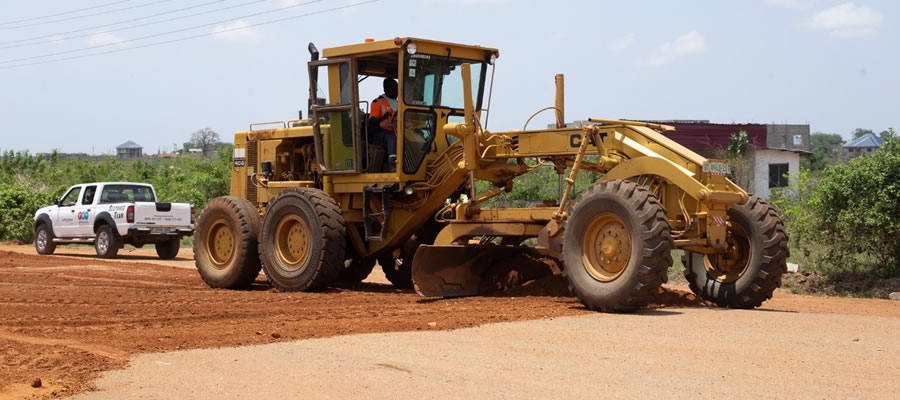

Agriculture
Most Districts in Ghana economy largely depends on agriculture and its growth is critical to overall economic growth and development; Kpone Katamanso is not different. Although majority of the people are in the industrial and the service sector, agriculture employs about 13.5 percent of the population. The Department of Agriculture (DoA) as a responsible department for policy and planning for the agriculture section of the Municipality has always responded to the national development initiatives with policies and strategies that address the sectors’ responsibilities in the national goods. For districts to achieve expected outcome from plans, it is necessary for districts to come out with workable plans (strategic plans) which will attract investors to invest in most public goods which previously was carried out by government.
Agricultural activities in the Municipality are very prominent and these can be grouped into crop and livestock production, fishing and agro-processing. Crop farming is predominant in the northern part of the Municipality and fishing dominates in the south.
Crop Production
Major crops produced in the Municipality are maize, cassava, tomatoes, onions, pepper and okro etc. Vegetables like cabbage, carrots, green pepper, spring onions, cucumber, lettuce, ‘Ayoyo’ and ‘Gboma’ are also cultivated in the Municipality. Tree crops such as mango, citrus, and pawpaw can be found in areas like Katamanso, Gbetsile and Appolonia.
The table below indicates the estimated area cultivated and crop yield from 2013 – 2017.
Tables above show the trend in crop production in the Kpone Katamanso Municipality. As indicated, average crop production has reduced significantly over the years. This can be attributed to a number of factors but prominent among them is urbanization. Other factors are outlined below:
a) Poor rainfall pattern;
b) Urbanization is taking over most farm lands;
c) High interest rates on loans;
d) Marketing difficulties especially with perishables during harvest seasons;
e) Lack of interest shown by the youth in farming;
f) some farmers are not practicing mechanized farming;
g) Land tenure problems.
Following from the reduction in cultivable lands in the Municipality, yield continues to reduce over the years. This is evident from the table 1.15 above. Thus it is evident from the table that from an initial total crop yield of 3,589.2 metric tons in 2013, the sector has seen a consistent decline in crop yield to 2,345.1 metric tons in 2016 and this can be attributed to the unavailability of cultivatable lands, infertility of the soils for cultivation due to both natural and manmade factors such as erosion, sand winning etc. Some other factors also include the use of primitive methods and the dependence on inconsistent rainfall which is due to recent climate changes instead of irrigational scheme.
Whiles the Municipality’s population has seen approximately 2.6% increase in population growth annually, the total crop yield has been decreasing on an average of 9% since 2013. This is a very serious threat to the Municipality’s food security as it is evident that the sector is unable to produce to meet the growing population.
The year 2014 was the highest hit as the sector saw about 768.05 metric tons which is about 21% decrease from the total crop yield the year before.
Some specific crops however did not tow this line as it has become clear that whiles there was a general fall in crop yield these crops were on an increase. For instance, Cassava has seen between 0.9% to 1.6% increases in its production due to the implementation of the West Africa Agricultural Productivity Program (WAPP) 2014 which ended in 2016.It is predicted that Cassava yield will fall significantly by the end of 2017 because the project ended in 2016. Onion also saw a yearly increase in its production from 2013 to the level of about 3% increase from 2015 to 2016. Other crops that increased even though quite marginally are exotic and leafy vegetables.
Water Melon has consistently being the highest contribution to the total number of crop yield for the sector and continuous to make about 1% increase each year even though Water Melon is not a crop that is mainly dependent on whiles leafy vegetables have also consistently remained the least contributor to the total crop yield.
Livestock Production
Animal rearing is gradually taken over from crop production as the major agricultural activity in the Municipality. The type of animal reared includes poultry (local and exotic fowls, ducks, geese, turkey, guinea fowls etc.) cattle, sheep, goats, pigs, rabbits and grass cutter. These animals are produced on both subsistence and commercial basis.
Industrialization and Estate development have led to the relocation of most poultry farms to other parts of the region whilst some few ones have folded up due to high cost of feeding the birds and Avian Influenza (Bird Flu) disease.
Fishing
Fishing and its related activities play a vital role in the economic development of the Municipality. Fishing is predominant in the Kpone area because the community is close to the sea. The type of fishing practiced includes ring net fishing, hooking and wide net fishing. The fishermen use local canoes operated by outboard motors for fishing. Those engaged in this activity have grouped themselves into associations. These associations are the Fish Mongers Association and the Cooperative Fishing Society. However, the Cooperative Fishing Society is now redundant due to poor management and lack of funds.
The fisher men sell their catch to the women at the Tema Harbour due to ready market and sometimes at the shores of the sea. These women do not only sell the fresh fish but also smoke some and sell within the Municipality as well Asamankese, Ada-Kasseh, Agbozume and the Afram Plains.
The fishing sector is however bewildered with some challenges if addressed could go a long way to improve the sector as well as the income levels of the people. These include:
a) High cost of outboard motors
b) High cost of pre-mix fuel
c) Interference from Pair trawlers
d) Lack of storage facilities
e) Broken dams
General Challenges Faced By the Agric Department Of KKMA
a) Lack of logistics (vehicle, motorbikes, safety wears, staff Identity cards. etc.) for effective extension delivery.
b) Late release of working funds to the department to implement plan activities.
c) Inadequate office space to accommodate office staff
Agriculture Extension
There are adequate number of agriculture extension agents in the Municipality and they operate in the various communities. Farmers within the various communities are able to access extension services and also important issues relevant for improved agricultural production through these agents are made known to farmers. This has helped to improve productivity over the period. This notwithstanding, extension agents should be well equipped and motivated to deliver their best so as to help increase productivity for food security in the Municipality
Date Created : 4/25/2023 12:00:00 AM












 facebook
facebook
 twitter
twitter
 Youtube
Youtube
 +233 593 831 280
+233 593 831 280 0800 430 430
0800 430 430 GPS: GE-231-4383
GPS: GE-231-4383 info@ghanadistricts.com
info@ghanadistricts.com Box GP1044, Accra, Ghana
Box GP1044, Accra, Ghana